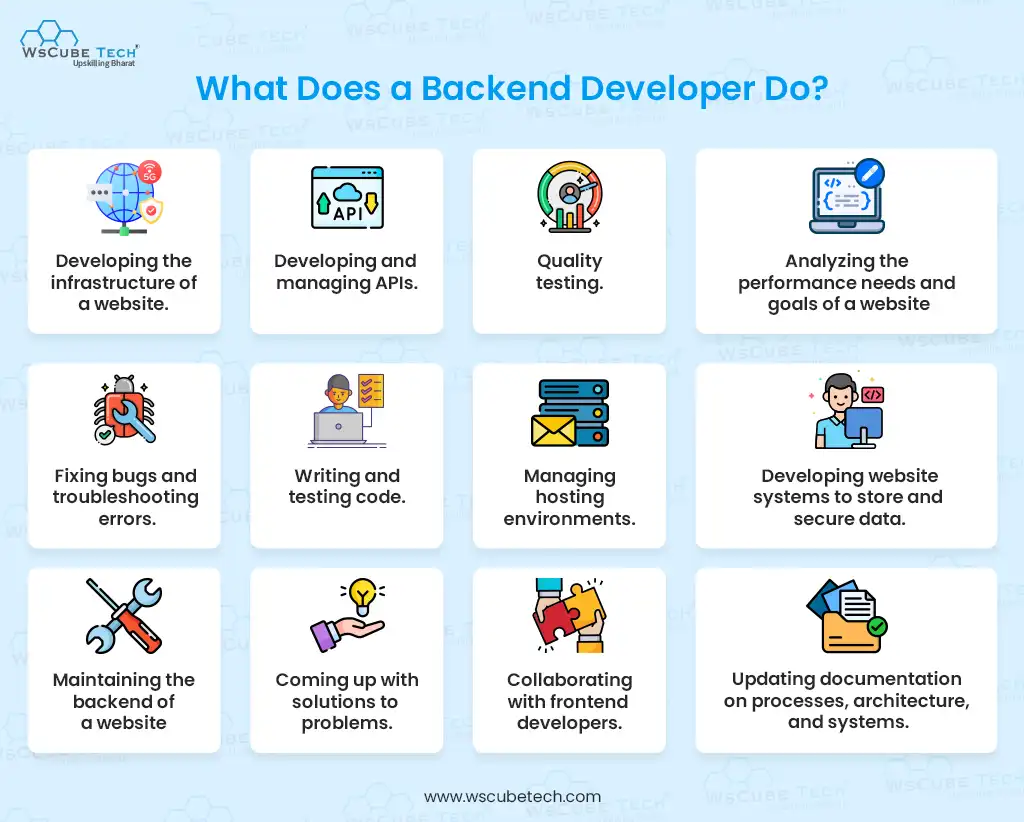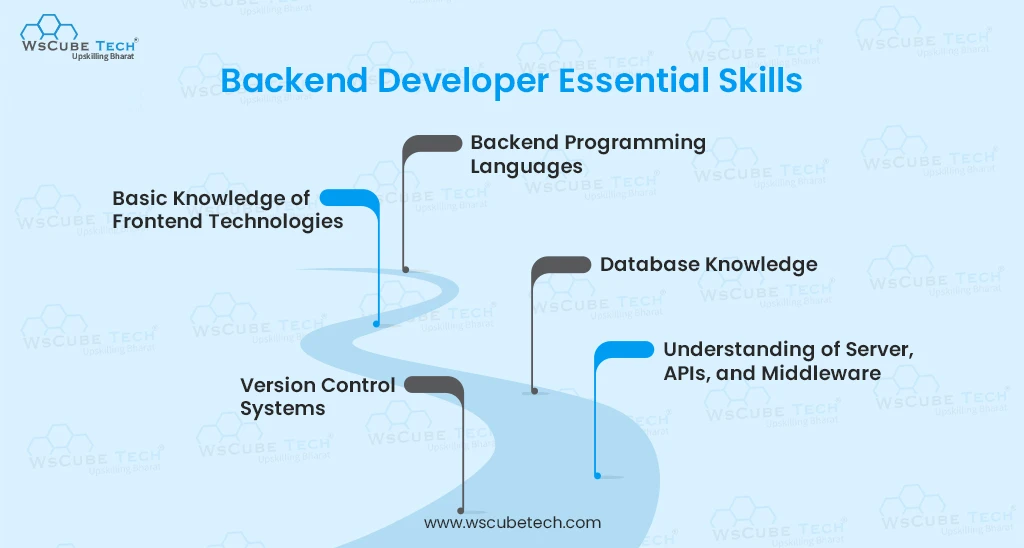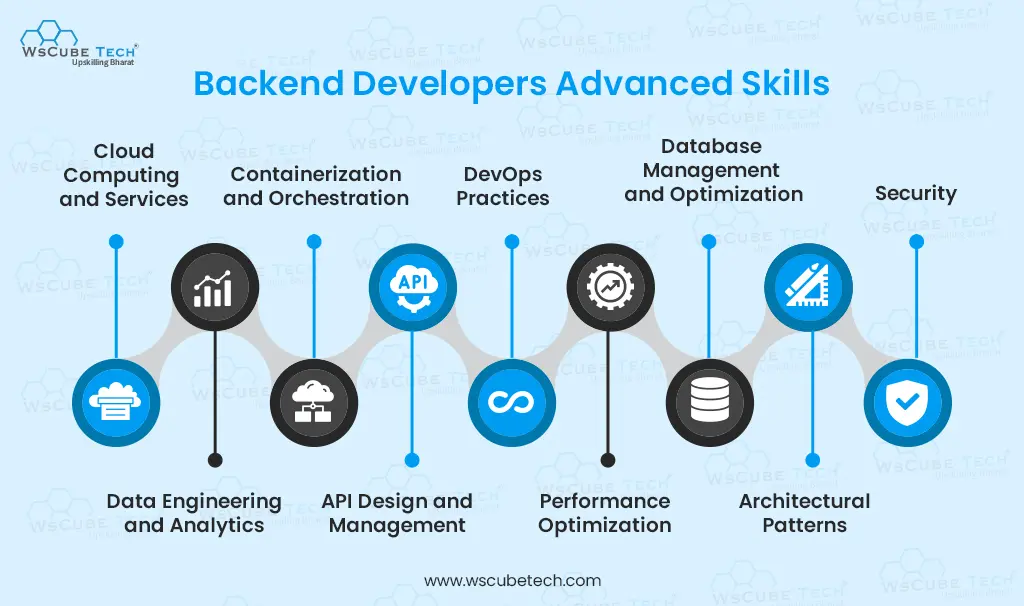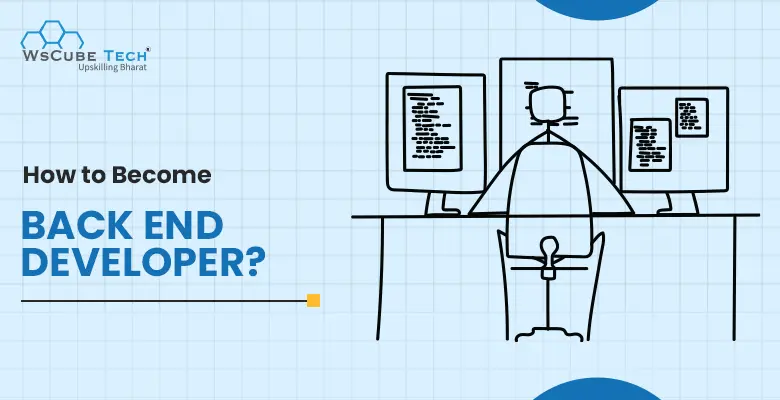We use websites and mobile apps so often these days that we hardly think about what’s happening behind those beautiful graphics and fancy buttons. But there is a hidden world beneath that makes all the magic happen. From cool designs and amazing features to vast data and everything else, it’s the combination of technology and code known as the backend.
In the world of technology, backend development is no less than a car engine that you can see only when you peek under the hood. It is among the high-paying IT jobs and high-income skills. However, you can feel the results while driving that car, which is like clicking on different buttons and using various features of an app or a website.
And the people responsible for handling this unseen world are called backend developers.
And many people still wonder “Is Web Development a Good Career?” Yes, it is among the most sought-after professions, with an average salary reaching up to INR 12 LPA. Companies need them to build powerful websites and apps.
However, they have a steep learning curve because they need knowledge of multiple programming languages and a set of additional soft skills.
If backend development sounds like an interesting job to you, then this guide is for you. We have shared the backend developer roadmap for 2025 in this blog so you can understand how to get started and make a career in the field. Let’s read.

Who is a Backend Developer?
Every website or web application has two components- backend and frontend. Visitors see, experience, and interact with the frontend side of a website. Any user with a non-technical background hardly thinks about what’s happening behind the scenes of web development and only focuses on what they see. However, that doesn’t imply that backend development or the job of a backend developer is less important.
Backend programming is crucial for providing a seamless user experience. Backend developers are a part of a large web development team, with primary attention to the server side of a website.
It’s usually related to databases, servers, content management systems, and other sections of programming required to support frontend or client-side. They build the section of a website that keeps the website running smoothly and efficiently.
Upskill Yourself With Live Training
What Does a Backend Developer Do?

Before we start learning about how to become back end developer, it’s important that you understand the job roles and responsibilities of back-end developers. They build a website’s architecture and write code to establish communication between the database of a website and the browser used by the visitor. In simple terms, they design and program systems to support a website by using different programming languages, such as Ruby, Python, Java, and PHP.
Once the website is launched, they implement and manage the database, optimize the website’s performance, analyze data, and troubleshoot issues. Here are the key job responsibilities of a backend developer:
- Developing the infrastructure of a website.
- Developing and managing APIs.
- Quality testing.
- Analyzing the performance needs and goals of a website to deliver effective solutions.
- Fixing bugs and troubleshooting errors.
- Writing and testing code.
- Managing hosting environments.
- Maintaining the backend of a website.
- Developing website systems to store and secure data.
- Coming up with solutions to problems.
- Updating documentation on processes, architecture, and systems.
- Collaborating with frontend developers to transfer data to the client side.
- Teaming up with other departments, including sales, marketing, product management, and customer support.
Also Read: Top 20 Front-end Development Projects in 2025
Essential Skills and Technologies for Backend Developer

To become a proficient backend developer, certain essential skills and technologies form the foundation of your expertise. These web development skills are crucial for building and maintaining the server-side logic and functionalities of web applications and services.
1. Backend Programming Languages
These are the popular backend programming languages:
- Python: Known for its readability and simplicity, Python is widely used for web development, data analysis, artificial intelligence, and more. It’s a great starting point due to its straightforward syntax and powerful frameworks like Django and Flask.
- Java: A staple in enterprise environments, Java is used for building scalable, robust web applications. It’s known for its portability across platforms, thanks to the JVM (Java Virtual Machine).
- JavaScript (Node.js): While traditionally a frontend language, JavaScript has become popular on the server-side with Node.js. Node.js allows for building fast, scalable network applications.
- Ruby: With the Ruby on Rails framework, Ruby is another excellent choice for beginners and startups due to its convention over configuration approach, which speeds up development.
- PHP: Despite mixed opinions, PHP powers a significant portion of the web (including WordPress sites). It’s easy to start with and has a vast ecosystem.
2. Database Knowledge
- Relational Databases (SQL): Understanding relational database management systems like MySQL, PostgreSQL, and SQLite is essential for managing structured data using SQL (Structured Query Language).
- NoSQL Databases: NoSQL databases like MongoDB, Cassandra, and Redis are designed for flexibility, scalability, and high performance with unstructured data. Knowing when and how to use these can be crucial for certain applications.
3. Understanding of Server, APIs, and Middleware
- Server Management: Knowledge of how to configure, manage, and deploy servers is crucial. This includes understanding web servers like Apache, Nginx, and cloud-based solutions.
- RESTful APIs and GraphQL: Creating and consuming APIs is a significant part of backend development. REST and GraphQL are popular methodologies for designing web APIs for applications to communicate with the server.
- Middleware: Middleware functions to handle requests and responses within your application’s request-response cycle. Understanding middleware is key for tasks like authentication, data processing, and routing.
4. Version Control Systems
Version control is critical for managing changes to codebases, collaborating with teams, and integrating changes. Git is the most widely used system, and familiarity with platforms like GitHub, GitLab, or Bitbucket is essential.
5. Basic Knowledge of Frontend Technologies
While not the main focus of backend developers, having a basic understanding of frontend development languages and technologies is beneficial for effective collaboration with frontend teams and for tasks that require a full-stack approach.
Also Read: How to Learn Coding & Programming in 2025? Best Ways
Backend Developer Roadmap 2025
If you are looking for the roadmap for backend developer, then here are a few essential steps to follow:
- Invest in Learning and Training
- Become Proficient in At Least One Programming Language
- Gain Knowledge About Frameworks and Databases
- Learn About APIs, Web Security, and Hosting
- Acquire Additional Skills
- Build a Portfolio
- Gain Hands-on Experience
- Start Applying for a Job or Be a Freelancer
Interview Questions for You to Prepare for Jobs
How to Become Backend Developer?
Let’s know the full roadmap for becoming a backend developer:
1. Invest in Learning and Training
Although there is no specific qualification or degree required to be a backend developer, it’s recommended to pursue a certification course from a reliable institute. You can opt for an online web development course or for a backend development training program.
Companies and hiring managers want backend developers with industry-recognized certificates and professional skills. As web development is a competitive field, aspirants need to do their best to set themselves apart from others.
Moreover, you should acquire basic web development skills to start your career, which includes expertise in HTML, CSS, and JavaScript. Make sure you know your way around GitHub and get a fair understanding of browser developer and web development tools to build websites and fix errors.
Also, you need to be familiar with data structures and algorithms as they are the building blocks of software. You can join an online full stack development course, watch podcasts and YouTube tutorials, read books, or refer to free resouces to learn backend development.

2. Become Proficient in At Least One Programming Language
Web development languages allow developers to command a computer. One of the most crucial steps in the backend developer roadmap 2025 is to learn at least one programming language in the beginning and gradually master more.
There are plenty of popular programming languages, some of which are C, C++, Python, Java, Ruby, PHP, etc. You can pick any of these at the beginning of your career and get well-versed in it. Depending on your career graph, job role, interest, and expertise, you can learn multiple languages later.
A programming language will be the server code to run a website. Start by assessing all the languages you can learn and pick the one that is accessible to you and interests you. This will ensure that you learn and master it faster.
If you’re not sure how to get started, check out this guide on how to learn coding or programming.
Furthermore, learn from industry leaders and professionals with our full stack developer course designed by experienced developers and mentors who have been in the industry for more than a decade.
Also Read: What is Full Stack Development? 2025 Guide
3. Gain Knowledge About Frameworks and Databases
Different frameworks are based on different programming languages, allowing developers and coders to build templates to add, edit, and modify code based on their requirements. They save time while programming a website; hence, learning about frameworks is crucial in a roadmap to backend developer.
Web programming languages are important to write code, but knowledge of frameworks enables developers to save valuable time by providing reusable code. It shows that you can make the development process more efficient and streamline it. You can use the same framework multiple times for various purposes. Some popular frameworks are Express, Django, and Ruby on Rails.
A database is a type of structured data storage space that one can access electronically. Some common examples of databases are MySQL and Oracle. Websites depend on some type of database, be it managing users or information.
For developers, databases are more than just user information; they are a vast amount of data that the server needs. Learning about databases is crucial as it will help you while developing a website.
Recommended Resources for You:
- Best Web Development Books
- Best Web Development Projects
- Best Backend Programming Languages
- Best Full Stack Developer Course
- Web Developer Salary in India
- JavaScript Programs
- Web Design vs Web Development
- Types of Web Development
4. Learn About APIs, Web Security, and Hosting
APIs are a software intermediary that enables communication between different applications. They are used to access data and interact with external components. Backend developers require APIs to connect services and improve user experience. Some of the important APIs that backend developers need to know about are JSON, REST, AES, GSON, SOAP, and XML-RPC.
The next key step in your journey to how to become a good backend developer is to gain expertise in web security. Websites are at risk of cyber attacks, which can lead to poor performance and data breaches.
There are various risks, such as blacklisting, malware, sensitive data exposure, and buffer overflow. Therefore, web security is essential to take necessary protective measures and protocols and keep a website optimized. Backend developers test websites for any vulnerabilities and defend them against data theft by hackers.
The following are a few effective techniques to avoid such risks:
a) HTTPS
It is a secured form of HTTP used to send data and protect it via the Transport Layer Security protocol. It has three strong layers of protection:
Encryption- It secures data by using a password or key to decrypt any sensitive information.
Authentication- It protects websites against cyber attacks and builds trust among users as the business grows.
Data Integrity- With secured data integrity, stored information is accurate, reliable, and complete.
b) Secure Data Backup and Recovery
Data loss is the biggest threat for developers as it can result in data loss or breach. So, developers implement a data backup process to avoid any such situation. Here are a few ways to implement backup and recovery:
- Regularly testing the backups.
- Protecting data from theft or destruction.
- Follow a two-person rule so that one person can’t access data without the permission of another.
The third important thing to learn as a backend developer is hosting. It’s not necessary that you will decide where the website will be hosted. However, get yourself familiar with different hosting options if you want to handle a project from the ground up.
You can choose from two hosting options- managed hosting servers and cloud hosting providers. The former is better for people with a non-technical background as the interface is more user-friendly. The latter option is used by tech-savvy people.
5. Acquire Additional Skills
Web development is a competitive industry, and you need to possess additional skills to be the top candidate during interviews. When students ask us about how to become a backend developer roadmap, we also recommend acquiring a few extra skills either during your training or on your own as you work on your job profile, portfolio, and resume.
Go through different job listings for backend developers and find out the skills that recruiters seek the most. You can focus on those capabilities and become a desirable applicant.
You don’t need any formal education to build these skills but need to invest a little extra time and effort to learn them. It can be technical or soft skills. For instance, you must know how to develop communication skills and work on these for development jobs.
a) Technical Skills
- REST (Representational State Transfer Architectural site) API, which is used to transfer data across applications.
- Modern CI/CD (Continuous integration, continuous delivery, and deployment) methodologies to deliver a project successfully to clients through automated testing and debugging.
- Modern data frameworks, such as Quarkus, Spring Boot, and Micronaut.
b) Soft Skills
- Problem-solving skills to put out fires, address technical issues, fix glitches, and provide creative solutions. It ensures that the project is always on track and is delivered within the stipulated time.
- Communication skills to interact with other team members effectively, whether it’s conveying your opinion or listening to others’ ideas.
- Collaboration skills to work seamlessly with designers, testers, developers, clients, and stakeholders.
6. Build a Portfolio
As hiring managers evaluate your job application, they would want to see your work through your portfolio. They would evaluate your skills and knowledge through the projects you have worked on.
So, make sure to create an impressive portfolio that highlights your best attributes related to backend development. It can include web development projects that you have worked on as a freelancer, during your training, or for yourself. A well-built portfolio can grab the attention of recruiters at once by showcasing your capabilities and making you a top candidate.
Also Read: Web Developer Job Description 2025 (Roles and Responsibilities)
7. Gain Hands-on Experience
One key step that many beginners avoid is gaining hands-on experience before kickstarting their professional journeys. Although theoretical knowledge is crucial, it alone won’t suffice if you want to make a promising career in the field.
So, to answer the question of how to be a backend developer, we would recommend getting practical experience. It will help you understand different techniques and formats behind different programming languages, and you will be able to write cleaner code. Analyze your errors, work on your weaknesses, and strive to become better.
To gain experience, you can either build your own web development projects, do internships, or join a part-time job in a small or non-profit organization. The experience you gain in the initial stage comes in handy during your full-time jobs by preparing you for different tough situations.
8. Start Applying for a Job or Be a Freelancer
Now that you have a strong portfolio and experience, it’s time to apply for backend jobs and be a professional developer. Create a strong resume highlighting all your skills, achievements, and expertise.
Go through the job description and list the skills mentioned by employers. Your resume should show that you are a good fit for the job. Before the interview, go through the top web development interview questions and be prepared.

Advanced Skills and Specializations for Backend Developers

Advancing beyond foundational knowledge in backend development opens up a spectrum of specialized skills and niches that can significantly enhance your career prospects, project opportunities, and potentially your earning potential.
Here’s an overview of advanced skills and specializations that backend developers can pursue to stand out in the tech industry:
1. Cloud Computing and Services
- Expertise in Cloud Platforms: Deep knowledge of services offered by AWS, Azure, or Google Cloud Platform (GCP) can make a developer invaluable. Specializing in cloud infrastructure design, management, and optimization for deploying scalable, reliable applications in the cloud is highly sought after.
- Serverless Architectures: Understanding how to build and deploy applications using serverless computing services (e.g., AWS Lambda, Azure Functions) can lead to more efficient and cost-effective development processes.
2. Containerization and Orchestration
- Docker: Proficiency in creating and managing Docker containers that package applications and their environments ensures consistency across development, testing, and production.
- Kubernetes: Expertise in orchestrating containerized applications with Kubernetes allows for managing complex applications at scale, improving deployment speed and reliability.
3. DevOps Practices
- Continuous Integration/Continuous Deployment (CI/CD): Mastery of CI/CD pipelines using tools like Jenkins, GitLab CI, or GitHub Actions enables automated testing and deployment, enhancing productivity and minimizing errors.
- Infrastructure as Code (IaC): Knowledge of managing infrastructure through code using tools like Terraform or AWS CloudFormation simplifies configuration and increases deployment efficiency.
4. Database Management and Optimization
- Advanced Database Design: Skills in designing efficient, scalable database schemas for relational and NoSQL databases can optimize data storage and retrieval, directly impacting application performance.
- Database Administration: Expertise in database tuning, replication, and sharding techniques ensures high availability and performance of data-driven applications.
5. Security
- Application Security: Advanced knowledge in securing applications against threats (e.g., XSS, CSRF, SQL injection) and implementing encryption, OAuth, JWT for secure data transmission and authentication.
- Infrastructure Security: Skills in securing server environments, implementing network security practices, and conducting vulnerability assessments protect against breaches and data leaks.
6. Data Engineering and Analytics
- Big Data Technologies: Experience with big data processing frameworks (e.g., Apache Hadoop, Spark) for handling large datasets and performing complex data analysis.
- Machine Learning Model Deployment: Understanding how to deploy and manage machine learning models within backend systems can add predictive capabilities to applications.
7. API Design and Management
- GraphQL: Deep understanding of designing and implementing efficient, flexible APIs using GraphQL, providing clients with the ability to request exactly the data they need.
- API Gateways and Management Tools: Skills in using API gateways for routing, monitoring, and securing API calls, along with knowledge of API documentation and versioning strategies.
8. Performance Optimization
Ability to use profiling tools and techniques to identify bottlenecks in applications and databases, and apply optimizations to improve speed and efficiency.
9. Architectural Patterns
- Microservices Architecture: Expertise in designing and implementing microservices architectures for building modular, scalable applications.
- Event-driven Architecture: Knowledge of building applications that respond dynamically to events, improving responsiveness and decoupling system components.
Free Courses for You
FAQs About Backend Developer Roadmap
Frontend development focuses on the visual and interactive aspects of a website or application that users interact with directly (using technologies like HTML, CSS, and JavaScript).
Backend development, on the other hand, deals with the server-side of applications, managing database interactions, user authentication, and server logic, ensuring that everything on the client-side works as intended.
While a degree in computer science or a related field can be beneficial, it is not strictly necessary to become a backend developer. Many developers are self-taught or have transitioned from other fields, using online resources or website development course, bootcamps, and practical experience to build their skills.
The timeline varies based on prior experience, the amount of time you can dedicate to learning, and how quickly you grasp new concepts. Generally, with consistent study and practice, you can acquire the basics in a few months. Becoming proficient, especially with more advanced topics, might take a year or more.
JavaScript with NodeJS is often recommended for beginners due to its high demand in today’s market, because it is part of MERN Stack. However, the best language to start with can depend on your interests and the specific areas of backend development you want to pursue.
Yes, backend developers can work remotely. Many companies offer remote positions for developers, especially in today’s digital-first world. The nature of backend development work, which primarily requires a computer and internet connection, makes it well-suited for remote work.
Beyond mastering one or more backend programming languages, you should familiarize yourself with database technologies (like MySQL, MongoDB), web servers (such as Apache, Nginx), version control systems (Git), and frameworks relevant to your chosen language (e.g., Express for Node.js, Django for Python).
While backend developers focus on server-side development, having a basic understanding of frontend technologies is beneficial. It improves collaboration with frontend teams and aids in building applications that deliver a seamless user experience.
Building personal projects is one of the best ways to gain practical experience. Contributing to open-source projects, participating in coding challenges, and internships can also provide hands-on experience and strengthen your understanding of backend technologies.
Certifications can demonstrate your knowledge and commitment to professional development but are not always necessary. Practical experience, a strong portfolio, and a deep understanding of backend technologies are typically more important to employers.
Follow tech blogs, join developer communities, participate in forums, and attend webinars or conferences. Continuous learning and networking with other professionals are key to staying updated with the latest trends and technologies in backend development.
A backend developer specializes in server-side development, focusing on databases, server logic, and application architecture. A full-stack developer, on the other hand, has the skills to work on both the frontend and backend parts of web applications, handling everything from user interface design to server and database management.
Conclusion
We hope this guide will help you start your career and get closer to your dream job. Becoming a successful and proficient backend developer demands time, effort, and hard work. There are no instant results, but you have to invest years to reach your ultimate professional goals. So, stay focused, give your best, and you will soon achieve what you desire.
If you want to become a full-fledged developer who can handle any project with confidence, then join our full-stack web developer course. Our experienced trainers conduct live interactive classes and help you become career-ready through hands-on projects. Wait no further and connect with our team to enroll in demo classes.
Read more blogs:



